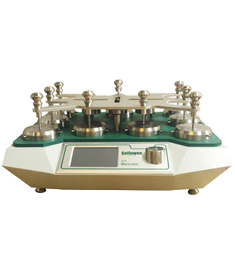
NewsInformation Center
Why are textiles prone to wear and tear? How to test?
2022/06/14
There are many types of textiles that fill our daily lives, and textile wear and tear is an unavoidable thing, so how to test the wear resistance of textiles?
The 4 main reasons for textile wear and tear.
1. Fiber extraction from the fabric, resulting in the loosening of the yarn and fabric structure, repeated action of the fiber may be completely pulled out, resulting in thinning of the yarn, thinning of the fabric, or even disintegration.
2. Fiber surface wear, fiber surface fragment loss.
3. Constant collision between fibers during friction, fiber fragments in the yarn break due to fatigue damage, resulting in the breakage of the yarn.
4. Friction generates high temperature, which causes melting or plastic deformation of fibers and affects the structure and mechanical properties of fibers.

How to test the degree of textile abrasion?
There are various methods to test the abrasion resistance of textile products, such as flat grinding method, curved grinding method, folded edge grinding method and compound grinding method. The Martindale method is one of the flat abrasion methods and is widely used to test the abrasion resistance of clothing, home textiles, decorative fabrics, and furniture fabrics.
The Martindale abrasion tester is used to test the abrasion resistance of the outer layer, lining, sole and similar fabrics of textiles, footwear, etc. Four specimens can be tested simultaneously. Product specifications: ASTM-D4966, BS-3424, DIN-53863, ISO-20344, SATRA TM31.
The abrasion resistance of fabric is generally analyzed and evaluated from three aspects: measurement of specimen breakage, measurement of mass loss and evaluation of appearance change.
1. Determination of specimen breakage: Under a certain load, the specimen in the fixture is rubbed against the abrasive with a trajectory of Lissajous curve plane movement, and the total number of rubbing times when the specimen is broken is used to determine the abrasion resistance of the fabric.
2. Determination of mass loss: Under a certain load, the specimen in the jig is rubbed with the abrasive with the trajectory of Lissajous curve plane movement, and the abrasion resistance is determined by the difference in mass before and after rubbing when the specimen is rubbed for a specific number of times.
3. Evaluation of appearance change: Under a certain load, the specimen in the jig is rubbed with the abrasive with the trajectory of Lissajous curve plane movement, and the abrasion resistance of the fabric is determined by the appearance change of the specimen before and after the friction.
After reading the above introduction, it is estimated that you have a new understanding of textiles, welcome customers who have purchased textile abrasion resistance instrument contact us!
Previous: What are the testing instruments for the textile industry?
N e x t : QS418 Textile Wet Penetration Tester



